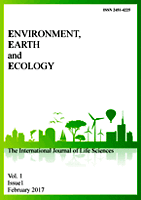| 1. |
Camargo FP, Tonello PS, dos Sanots ACA, Duarte ICS (2016) Removal of Toxic Metals from Sewage Sludge Through Chemical, Physical, and Biological Treatments - a Review. Water Air Soil Pollution 227:433. https://doi.org/10.1007/s11270....
|
| 2. |
Chen S (2019) Occurrence characteristics and ecological risk assessment of heavy metals in sewage sludge. OP Conf. Series: Earth and Environmental Science 295: 052041. http://doi:10.1088/1755-1315/2....
|
| 3. |
Council Directive of 12th June 1986 on the Protection of the Environment, and in Particular of the Soil, When Sewage Sludge Is Used in Agriculture (86/278/EEC). Available online: https://eur-lex.europa.eu/lega....
|
| 4. |
Duan B, Zhang W, Zheng H, Wu C, Zhang Q, Bu Y (2017) Comparison of Health Risk Assessments of Heavy Metals and As in Sewage Sludge from Wastewater Treatment Plants (WWTPs) for Adults and Children in the Urban District of Taiyuan, China. International Journal of Environmental Research and Public Health 14:1194. https://doi.org/10.3390/ijerph....
|
| 5. |
Gusiatin ZM, Kulikowska D, Klik BK, Hajdukiewicz K (2018) Ecological Risk Assessment of Sewage Sludge From Municipal Wastewater Treatment Plants: A Case Study. Journal of Environmental Science and Health, Part A 53: 1167–1176. https://doi.org/10.1080/109345....
|
| 6. |
Hakanson L (1980) Ecological Risk Index For Aquatic Pollution Control, a Sedimentological Approach. Water Research 14: 975–1001. https://doi.org/10.1016/0043-1....
|
| 7. |
Ikem A, Egiebor N.O, Nyavor K (2003) Trace elements in water fish and sediment from Tuskegee Lake, Southeastern USA. Water, Air, and Soil Pollution 149:51–75. https://doi.org/10.1023/A:1025....
|
| 8. |
Kabata-Pendias A (2011) Trace Elements in Soils and Plants, 4th ed.; Taylor & Francis: London, UK, 41–42.
|
| 9. |
Liu J, Zhou Z, Sun S, Ning X, Zhao S, Xie W, Wang Y, Zheng L, Huang R., Li B (2015) Concentrations of heavy metals in six municipal sludges from Guangzhou and their potential ecological risk assessment for agricultural land use. Polish Journal of Environmental Studies 24:165–174. https://doi.org/10.15244/pjoes....
|
| 10. |
Macdonald DD, Ingersoll CG, Berger TA (2000) Development and evaluation of consensus-based sediment quality guidelines for freshwater ecosystems. Archives of Environmental Contamination and Toxicology 39: 20–31. https://doi.org/10.1007/s00244....
|
| 11. |
Müller G (1969) Index of Geoaccumulation in Sediments of the Rhine River. Geo Journal 2: 108–118.
|
| 12. |
Perin G, Craboledda L, Lucchese M et al. (1985) Heavy Metal Speciation in the Sediments of Northern Adriatic Sea - A New Approach for Environmental Toxicity Determination. In: Lakkas TD, editor. Heavy Metal in the Environment 2. CEP Consultants; Edinburgh, Scotland 454–456.
|
| 13. |
Sakan SM, Djordjevic DS, Manojlovic DD, Polic PS (2009) Assessment of heavy metal pollutants accumulation in the Tisza river sediments. Jorunal of Environmetal Management 90:3382–3390. https://doi.org/10.1016/j.jenv....
|
| 14. |
Spanos T, Ene A, Styliani Patronidou C, Xatzixristou C (2016) Temporal variability of sewage sludge heavy metal content from Greek wastewater treatment plants. Ecological Chemistry and Engineering 23: 271–283. https://doi.org/10.1515/eces-2....
|
| 15. |
Tiruneh AT, Fadiran AO, Mtshali JS (2014) Evaluation of the risk of heavy metals in sewage sludge intended for agricultural application in Swaziland. International Journal of Environmental Science and Technology 5: 197–216. http://doi: 10.6088/ijes.2014050100017.
|
| 16. |
Tytła M (2019) Assessment of Heavy Metal Pollution and Potential Ecological Risk in Sewage Sludge from Municipal Wastewater Treatment Plant Located in the Most Industrialized Region in Poland - Case Study. International Journal of Environmental Research and Public Health 16:2430. https://doi.org/10.3390/ijerph....
|
| 17. |
Tytła (2020) Identification of the Chemical Forms of Heavy Metals in Municipal Sewage Sludge as a Critical Element of Ecological Risk Assessment in Terms of Its Agricultural or Natural Use. International Journal of Environmental Research and Public Health 17:4640. https://doi.org/10.3390/ijerph....
|
| 18. |
Ure AM, Quevauviller P, Mantau H, Griepink B (1993) Speciation of heavy metals in soils and sediments. An account of the improvement and harmonization of extraction techniques undertaken under the auspices of the BRC of the Commission of the European Communities. International Journal of Environmental Analytical Chemistry 51:135–151. https://doi.org/10.1080/030673....
|
| 19. |
Wang C, Li XC, Ma HT, Qian J, Zhai JB (2006) Distribution of extractable fractions of heavy metals in sludge during the wastewater treatment process. Journal of Hazardous Materials 137:1277–1283. https://doi.org/10.1016/j.jhaz....
|
| 20. |
Zhao S, Feng C, Yang Y, Niu J, Shen Z (2012) Risk assessment of sedimentary metals in the Yangtze Estuary: New evidence of the relationships between two typical index methods. Journal of Hazardous Materials 241–242:164–172. https://doi.org/10.1016/j.jhaz....
|








